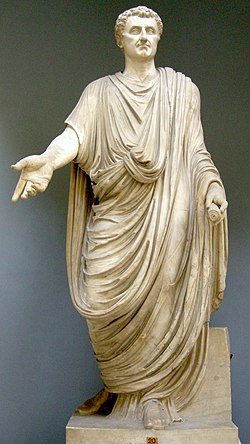Women
Free-born women in ancient Rome were citizens (cives), but could not vote or hold political office. Women were under exclusive control of their paterfamilias, which was either their father, husband, or sometimes their eldest brother. [2] Women, and their children, took on the social status of their paterfamilias. Women were not included in the political sphere, and they had little influence outside the home. However, women of wealthier families had more political power than poorer women as they were able to exert their influence behind the scenes of public, political actions. [7]
There were three early forms of marriage that transferred Roman women from one paterfamilias to another. The first, coemptio , represented the purchase of the bride. [2] [8] This oldest form of marriage required five witnesses and an official, and was treated as a business transaction. [8] The second, usus, occurred after one year of intimacy between a man and a woman. [8] If the woman did not leave the man for three nights following the year, she became the man's possession and he became her paterfamilias. If the woman left before the three nights were over, she would return to her family. The relationship would still be valid, but the man would not become her paterfamilias. [8] The last form of marriage, confarreatio, was the closest to modern marriage. Confarreatio was a religious ceremony that consisted of the bride and groom sharing bread in front of religious officials and other witnesses. [8]
By the end of the second century AD, marriages sine manu were the standard form of marriage. [2] Through a marriage sine manu, women did not fall under the legal jurisdictions of their new husbands or their fathers. They controlled their own property (usually their dowry) after the death of their father. [2] Men still had to sign any paperwork on behalf of their women, but there were now two economic units in the marriage. Moreover, divorce could be initiated by either man or woman, often by saying "I divorce you" three times while in front of witnesses. [2]
The legal status of a mother as a citizen affected her son's citizenship. The phrase ex duobus civibus Romanis natos ("children born of two Roman citizens") indicates that a Roman woman was regarded as having citizen status, in specific contrast to a peregrina .




